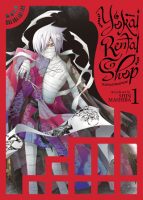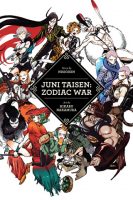My News and Reviews
Last week at Experiments in Manga I announced the winner of the Oresama Teacher giveaway. The post also includes a select list of some of the manga released in English that have notable delinquents (and in some cases ex-delinquents) in them. In licensing news, Dark Horse recently announced that it will be releasing The Flame Dragon Knight, a novel by Makoto Fukami which is based on Kentaro Miura’s manga series Berserk. Also, Yen Press is adding more yuri to its catalog: the manga anthology Eclair and the light novel adaptation of Napping Princess will both be released in English in 2018.
Quick Takes
 Yokai Rental Shop, Volume 1 by Shin Mashiba. I greatly enjoyed Mashiba’s earlier manga series Nightmare Inspector: Yumekui Kenbun and so was very excited when Yokai Rental Shop was licensed. I have been looking forward to giving the manga a try not only because of Mashiba’s involvement but also because yokai play a prominent role. Hiiragi is a public servant who recently learned, on his mother’s deathbed, that he has a half-brother. Initially he’s thrilled, but then he actually meets Karasu, a man who doesn’t hesitate to help his customers realize their darkest desires. So far, Yokai Rental Shop has yet to really distinguish itself from any number of other horror series featuring a supernatural boutique. Additionally, one of the things that made Nightmare Inspector so engaging–the use of a wide variety of illustration styles–is largely missing from Yokai Rental Shop. The major exception to this is how most of the yokai in the spirit district are drawn to be more reminiscent of traditional ink drawings, an artistic touch that I particularly appreciated. While at this point Nightmare Inspector would seem to be the stronger manga of the two, there’s enough about Yokai Rental Shop that interests me that I plan on continuing the short series.
Yokai Rental Shop, Volume 1 by Shin Mashiba. I greatly enjoyed Mashiba’s earlier manga series Nightmare Inspector: Yumekui Kenbun and so was very excited when Yokai Rental Shop was licensed. I have been looking forward to giving the manga a try not only because of Mashiba’s involvement but also because yokai play a prominent role. Hiiragi is a public servant who recently learned, on his mother’s deathbed, that he has a half-brother. Initially he’s thrilled, but then he actually meets Karasu, a man who doesn’t hesitate to help his customers realize their darkest desires. So far, Yokai Rental Shop has yet to really distinguish itself from any number of other horror series featuring a supernatural boutique. Additionally, one of the things that made Nightmare Inspector so engaging–the use of a wide variety of illustration styles–is largely missing from Yokai Rental Shop. The major exception to this is how most of the yokai in the spirit district are drawn to be more reminiscent of traditional ink drawings, an artistic touch that I particularly appreciated. While at this point Nightmare Inspector would seem to be the stronger manga of the two, there’s enough about Yokai Rental Shop that interests me that I plan on continuing the short series.
 Otomo: A Global Tribute to the Mind Behind Akira edited by Julien Brugeas and Ben Applegate. In 2015, Katsuhiro Otomo won the Angoulême International Comics Festival’s Grand Prix, a prestigious award recognizing comics creators for their lifetime achievements. As part of the celebration, an art exhibition showing work by creators from around the world in a tribute to Otomo was held. A limited-edition catalog of illustrations was also produced at that time, becoming the basis for the Otomo artbook. The English-language edition expands upon the original and includes contributions from more than eighty creatives, resulting in an attractive, oversized, 168-paged hardcover volume. Otomo is probably best known as the creator of Akira, so it isn’t too surprising that most of the artwork in Otomo make reference to either the anime or manga version of that story, but other works like Domu also provide a source of inspiration. There is a fantastic variety and a great range of styles represented in Otomo; some of the individual pieces are truly stunning. Accompanying each illustration is a short biography of the artist. Some also include a section in which the contributors write about their encounters with Otomo and his work. (I wish there were more of these.)
Otomo: A Global Tribute to the Mind Behind Akira edited by Julien Brugeas and Ben Applegate. In 2015, Katsuhiro Otomo won the Angoulême International Comics Festival’s Grand Prix, a prestigious award recognizing comics creators for their lifetime achievements. As part of the celebration, an art exhibition showing work by creators from around the world in a tribute to Otomo was held. A limited-edition catalog of illustrations was also produced at that time, becoming the basis for the Otomo artbook. The English-language edition expands upon the original and includes contributions from more than eighty creatives, resulting in an attractive, oversized, 168-paged hardcover volume. Otomo is probably best known as the creator of Akira, so it isn’t too surprising that most of the artwork in Otomo make reference to either the anime or manga version of that story, but other works like Domu also provide a source of inspiration. There is a fantastic variety and a great range of styles represented in Otomo; some of the individual pieces are truly stunning. Accompanying each illustration is a short biography of the artist. Some also include a section in which the contributors write about their encounters with Otomo and his work. (I wish there were more of these.)
 Juni Taisen: Zodiac War written by Nisiosin, illustrated by Hikaru Nakamura. My interest in the Juni Taisen novel largely stemmed from creators associated with it. Nisiosin seems to be something of a cult favorite and has had a fair number of stories translated recently (Juni Taisen is actually the first that I’ve read, however) and Nakamura is the creator of Saint Young Men and Arakawa Under the Bridge (it turns out Nakamura’s contributions to the novel are fairly limited). On top of having notable creators, the physical production and design of Viz Media’s release of Juni Taisen is beautiful. I have also been known to enjoy battle royale-type stories. Sadly, Juni Taisen is rather unsatisfactory as a novel and comes across as superficial, though I suspect the related manga and anime will be more successful. Twelve characters, none of them particularly likeable, are brought together in a battle to the death known as the Zodiac War. The winner will be granted a single wish, although there’s an even greater purpose to the contest. Juni Taisen has potential. The various super powers and abilities of the characters result in tactics and strategies that are interesting and even clever. Unfortunately, the coolness factor is undermined by inconsistent logic, repetitiveness, predictable narrative developments, and a sore lack of worldbuilding and a meaningful context.
Juni Taisen: Zodiac War written by Nisiosin, illustrated by Hikaru Nakamura. My interest in the Juni Taisen novel largely stemmed from creators associated with it. Nisiosin seems to be something of a cult favorite and has had a fair number of stories translated recently (Juni Taisen is actually the first that I’ve read, however) and Nakamura is the creator of Saint Young Men and Arakawa Under the Bridge (it turns out Nakamura’s contributions to the novel are fairly limited). On top of having notable creators, the physical production and design of Viz Media’s release of Juni Taisen is beautiful. I have also been known to enjoy battle royale-type stories. Sadly, Juni Taisen is rather unsatisfactory as a novel and comes across as superficial, though I suspect the related manga and anime will be more successful. Twelve characters, none of them particularly likeable, are brought together in a battle to the death known as the Zodiac War. The winner will be granted a single wish, although there’s an even greater purpose to the contest. Juni Taisen has potential. The various super powers and abilities of the characters result in tactics and strategies that are interesting and even clever. Unfortunately, the coolness factor is undermined by inconsistent logic, repetitiveness, predictable narrative developments, and a sore lack of worldbuilding and a meaningful context.

Speak Your Mind